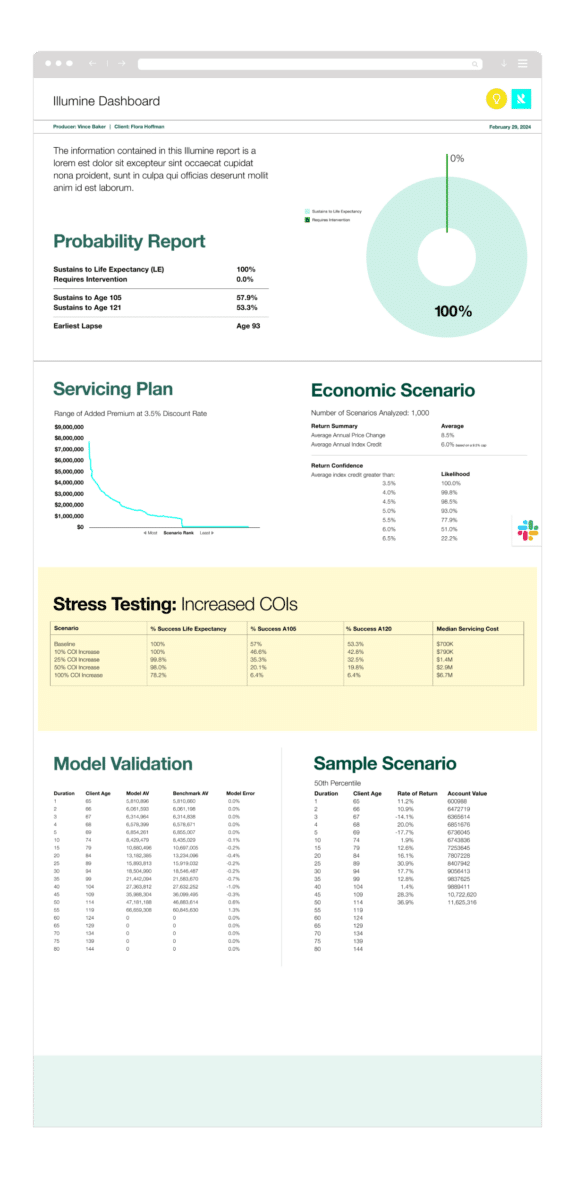Introducing Illumine™
A sophisticated tool for sophisticated advisors
by The Ridgeback Group
Introducing Illumine™

by The Ridgeback Group
Everyone knows life insurance illustrations are broken. But only The Ridgeback Group is offering up a solution. It’s called Illumine™ (patent pending), and it’s a next-generation life insurance analysis tool that’s built on proprietary modeling methods that show how likely it is that a policy will pay out to the insured’s beneficiaries — powerful information that helps a producer and their client choose the policy that’s best, not just cheapest.
They say a good craftsman never blames his tools. And yet, producers too often are forced to rely on an outdated, misguided, and sometimes even inaccurate tool: The illustration.
Despite being perhaps the most important (and frequently used) tool in an advisor’s toolbox, illustrations haven’t changed much in a long time, leaving clients with, at best, a misunderstanding of what type of policy might be right for them. Presented with an overwhelming array of options, a client often makes the understandable decision to just go with the cheapest policy, which is a bit like trying to build a Super Bowl-winning football team and using only players making the veteran minimum.
A better tool would help a client understand their policy options in full. It would tell them the cost, yes, but also the chances the policy would pay out when the time comes. It would tell a client how changes in the economy might affect their policy — not just tomorrow, but in five, twenty, or even fifty years. It would rely on cutting-edge technology that can run countless simulations to model the best potential outcomes for your client, and answer the ultimate question: How likely is it that the policy will actually be paid out to your client’s beneficiaries when they die?
And you would call that tool Illumine™ — because it’s already here. Using proprietary modeling methods, Illumine™ allows advisors to show their clients which policies are likeliest to pay out, under various scenarios (including how the economy is performing). It’s the brainchild of The Ridgeback Group’s COO and resident life insurance nerd, Eric Eklund, Esq. and Brendan Costello, an actuary and data savant.
Here’s what the dynamic duo told us about Illumine™ — and how it can raise you and your client’s insurance IQ.

Eric: There’s an old joke/adage: What’s the best type of life insurance policy to own? And the answer is: The one that’s enforced when you die. Illumine™ exists to do one specific thing—answer the question of: How do you know?
Brendan: That’s the hardest thing when it comes to life insurance, right? The reality is it can be tough to know. We’re talking about 30-, 40-, 50-year contracts, often that have some sort of investment component. We can’t know the future with certainty. So we have to be smart about how we try to understand life insurance policies, both when they’re sold and when we review them over time.
Most people understand their life insurance policies through illustrations provided by the insurance carrier. They’re universally agreed to be terrible and not reliable. Even the regulators will say you should not use this illustration to try and understand anything about your product.
What Illumine™ is saying is, “Is there a different way to look at this?” And we think the answer is yes.

Eric: The most powerful thing is it answers questions that clients didn’t even realize that they had. It raises a policy owner’s IQ. It can create an extremely informed buyer with very little education required.
Brendan: This is a tool that also helps smart agents be smarter. Producers can ask better questions when they’re designing a contract for a client. They can ask carriers better questions because they can start to understand where things can go wrong and why they go wrong.
Eric: We have what we’ll call a patent-pending precision product emulator. Brendan can explain it.
Brendan: There is a two-part process. The first part is what we call precision emulation. Inside Illumine™ is a life insurance policy projection model where we can simulate the performance of a life insurance policy over the entire life of the policy. Over several decades, we can do that as many times as we want, reflecting the policy parameters that we need. This is the key piece: Where we say precision emulation, we can replicate the performance of pretty much any product that’s on the market. We’re able to take information that the carrier provides, through their illustrations or their policy contracts, and replicate those mechanics within our system. And we have a series of algorithms that Illumine™ uses to make sure that that emulation is as accurate as it reasonably can be.
Once we have emulated someone’s product within our system, there’s what we call a stochastic projection model. We can run through all the decades the policy is going to be on the books, and we can do that thousands of times over under varying performance economic performance simulations, which allows us to see how the policy is going to perform. If the market is good, if the market is bad, etc.
A lot of times when we’re running Illumine™, it’s just about how sensitive my policy is to market performance. But we can also vary any other aspect of the policy, including things like “What happens if my premiums are different than I planned?” Or “What happens if the carrier changes the terms of the crediting rate on a policy?” This is something carriers do regularly, and we can test those variations and see how the policy is going to perform in those different situations, through these thousands of simulations. We can say this portion of those simulations results in the policy being enforced, and the other portion results in the policy failing.
Eric: That’s great. And what’s the upshot for a policy buyer or policyholder?
Brendan: We report that information back to the user. Then you can start to tweak and say, Well, what’s it going to take If I want to be 90% sure my policy is going to be enforced? What does it take if I want to be 100% sure?
It also allows clients and agents to have healthy conversations. Instead of talking about how cheap an insurance policy is going to be, you can discuss how much you have to pay to have the confidence you’re looking for. That in turn opens up a conversation about being proactive, about taking care of your policy over time, rather than saying, I’m just going to put as much or as little money into this as I can and forget about it. That’s what happens far too often today.
In no other market do people think that the cheapest product is the best. I don't know why people assume that in insurance. It’s absolutely insane.”Brendan Costello

Eric: Somebody asked me once what’s the least predictable part of an insurance policy’s performance. And I said, the premium payer. The mechanics of a product work as long as the policy owner pays their scheduled premiums on time and manages their policy.
Brendan: I love that line. Insurance is really about managing and limiting risk. But inherent in these long-term contracts is risk. Especially the types of policies we sell the most, which are flexible-premium policies, where the client can vary when they pay their premium. Some premiums also have their performance linked to the markets.
When it comes to life insurance, there’s a risk you want to take on and a risk you don’t want to take on. In my personal opinion, things like having the flexibility to pay premiums whenever I want means there’s a risk that I won’t pay my premiums on time. But I can control that risk. I can understand that risk. I can manage that risk.
On the investment side, carriers have to invest very conservatively. But I can choose to go a little bit more aggressive [with my own money]. So I think there are a lot of advantages to taking on some risk within your insurance contract.
It all comes back to, How do I understand the risk I’m taking on? And how risky is it? And I think that’s why, with Illumine™, we like that question of what’s the probability my life insurance policy is enforced when I die? Versus what people usually judge their policies on today, which is: What is the cheapest policy for me on an illustration?
Eric: Great point.
Brendan: In no other market do people think that the cheapest product is the best. I don’t know why people assume that in insurance. It’s absolutely insane.
So you need some other way of measuring and understanding what’s going on. Illustrations make that at best very difficult, and at worst just impossible. Illumine™ makes it clear because we translate your policy performance into something that I think is much more understandable, which is: This policy has an X% chance of success. And this policy has a Y% chance of success.
Eric: Here’s the other thing: What Illumine™ allows us to do is not only write new business with greater certainty, but also to go back and look at what previously issued policies are doing, and what’s required to keep them going. That can be a policy that’s a year old. It can be a policy that’s 25 years old. That allows the insured to make different decisions.
Maybe they want to pay less premiums. Maybe they want to pay more premiums to keep the policy enforced longer. Maybe they want to adjust the death benefit down. Maybe they want to take more or less risk in their investments. And what if the carrier changes the interest crediting rate? What if the carrier changes the costs of insurance? We report on all of these possibilities.
Illumine™ gives my firm the ability to analyze our book and objectively assess how we and the carriers are doing in delivering on our promises to clients and advisors.”Keith Friedman
To request a demo of Illumine™, led by its co-creators, please reach out to:
